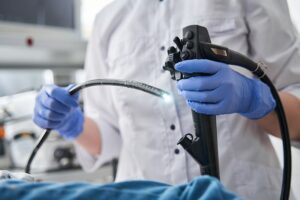Endoscopies: The Types, Their Purposes, and What To Expect

There are many ways a doctor can see your insides. However, when it comes to your digestion, only one procedure can see the full journey your food travels.
The gastrointestinal endoscopy, which typically involves the use of a thin, camera-equipped tube (endoscope) to see inside your digestive tract, is a common and safe diagnostic procedure. Nearly 25 million endoscopies are performed in the United States every year, including about 12,000 here at Cincinnati GI.
Still, many people are unsure what to expect. Let’s scope it out.
Explaining the Basics: Upper and Lower Endoscopies
If you are experiencing a digestive issue, there’s likely an endoscopy to screen for it. Endoscopies can detect a range of conditions including colorectal cancer, gastroesophageal reflux disease (GERD), celiac disease, gastrointestinal bleeding, gastroparesis (delayed stomach emptying due to weakened muscles), and inflammatory bowel disease.
There are two types of endoscopies: an upper endoscopy, which examines the esophagus, stomach, and small intestines; and a lower endoscopy, or colonoscopy, which examines the lining of the large intestine, colon, and rectum.
Upper and lower endoscopies can each be performed in a variety of ways, using different technologies. Depending on the condition, the endoscopy might not even involve an actual scope.
The Variations of Endoscopies
At Cincinnati GI, we offer well more than a dozen gastrointestinal tests. Following are some of the endoscopic options you might be prescribed.
Capsule endoscopy – A capsule endoscopy requires swallowing a pill-sized capsule containing a tiny camera. The camera takes images as it travels through the gastrointestinal tract, transmitting them to a recorder the patient wears, until it passes in a bowel movement (it is disposable). Often, a capsule endoscopy is advised to screen the small intestine, which is otherwise difficult to examine.
Colonoscopy – Now advised for anyone at age 45, a colonoscopy evaluates the health of the lower intestine, or colon, by screening for polyps (pre-cancerous cell growths) and other abnormalities. It relies on similar technology as an endoscopy, but the scope is inserted through the anus. If the screening reveals polyps, the doctor will remove them for testing.
Endoscopic mucosal resection (EMR) – An option for treating pre- and early-stage cancers, an EMR is often prescribed for Barrett’s esophagus, a complication of GERD that raises the risk of esophageal cancer. The surgeon reaches the affected area using the endoscope, through which surgical instruments can be passed to remove damaged tissue.
Endoscopic retrograde cholangiopancreatography (ERCP) – A combination of an upper endoscopy and X-rays, this procedure can gauge and treat stones and other conditions in the pancreatic and bile ducts. A dye is administered through the endoscope to enable the X-ray to capture abnormalities. If stones are detected, they can be removed using applied instruments.
Endoscopic ultrasound – This diagnostic procedure combines an endoscopy with ultrasound technology – the use of sound waves to create images. The doctor typically relies on this method to evaluate for cysts, lesions, and stones. If something unusual is spotted, instruments are fed through the endoscope to take samples. It is an advised option for difficult-to-access areas.
Sigmoidoscopy – Sometimes, only part of the colon needs to be examined, such as when the patient experiences bleeding, inflammatory bowel disease, or hemorrhoids. This test is similar to a colonoscopy – a tiny tube is inserted through the anus to transmit images to the doctor – but is limited to the sigmoid, the last part of the colon that connects the large intestine to the rectum.
Small bowel enteroscopy – Another test designed to examine the small intestine, this screening involves a longer variation of the endoscope to reach the small intestine, through the mouth. In some cases, balloons are attached to the scope to inflate the area being examined.
Upper endoscopy – This minimally invasive procedure examines you from the esophagus, where food travels, to the top of the small intestines, including your stomach. The doctor feeds the endoscope through your mouth to the targeted locations, from where it sends images to review. Typically, the test screens for inflammation, GERD, and other complications, including swallowing disorders and gastrointestinal cancers.
Endoscopies Are Life Savers
Thanks to advancements in science, endoscopies can be performed with minimum discomfort. The patient is sedated in many cases, and post-procedure side effects are typically limited to a sore throat.
And because endoscopies assess, treat, and prevent health conditions (in the case of colonoscopies), you’ll likely emerge from the procedure with a healthier digestive tract.
Click here to learn more about all of the treatment options we offer at Cincinnati GI.
